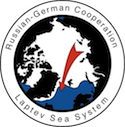 Task 3B
Task 3B
Changes of the hydrochemical structure of the Laptev Sea (TRANSDRIFT XXIV + XXV)
The goal of this task is to determine the long-term and seasonal variability of the hydro-chemical structure and nutrient distribution on the Laptev Sea shelf, including the processes of water-mass transformation in the frontal zones of the river plume and at the shelf edge. Task B also aims to assess the implications of the changes in freshwater supply, stratification and length of the ice-free period for marine primary production. These investigations are sup-ported by the multi-year hydrochemical datasets that have been generated within the frame-work of the research project “Laptev Sea System” and information derived from the Russian historical dataset. In addition, the year-round determination of nitrate concentration and pH will provide new information on chemical and biological processes affecting the nitrogen cyc¬le and its seasonality. For the first time the measurement of turbulent mixing rates through the pycnocline will allow directly determining the vertical fluxes of dissolved nutrients across density gradients, e.g., from nutrient-rich bottom waters to the photic surface layer.
Water sampling and analysis of dissolved oxygen, silicate, phosphate, total phosphorus, nitrate, nitrite, ammonia and total nitrogen, dissolved and particulate organic matter, pH, total alkalinity and chlorophyll a will be carried out during the TRANSDRIFT XXIV and XXV ex-peditions to the Laptev Sea in 2017 and 2018, respectively, and be combined with the isotopic composition of dissolved Ba, Si, Nd and O isotopes of the water and Ba and REE concentrations to be obtained from Task A. Archived and new data will be analyzed and compared to evaluate the variability of the hydrochemical conditions on the Laptev Sea shelf.
The task team will (a) quantify the seasonal changes of nitrate, and pH using sen¬sors mounted on ocean observatories, (b) assess the seasonal variability of hydrochemical parameters, (c) explore the processes of nitrogen accumulation in winter and estimate the intensity of nutrient consumption during the phytoplankton spring bloom, (d) obtain esti¬mations of nutrient reservoirs and fluxes on the shelf, and (e) assess the intensity of nutrient fluxes from nutrient-rich deeper water layers to the photic layer at the sea surface.
The contribution of the AWI team will comprise the analysis of the dissolved and particulate organic matter, the measurement of turbulent mixing rates through the pycnocline with a mi-crostructure sensor (turbulence), and year-round measurements of ecological parameters (chlorophyll, colored dissolved organic matter, etc.) with ocean observatories deployed in the northwestern Laptev Sea. The AARI team will mea¬sure dissolved nutrients, oxygen, pH, total alkalinity and chlorophyll a during the cruises in 2017 and 2018, analyze the nitrate-sensor data from the ocean observatories to quantify the processes of nitrogen accumulation in winter and spring, and estimate nutrient reservoirs and fluxes on the shelf. The GEOMAR team will complement this work by isotopic characte¬ri¬zation (Ba, Si, Nd and O isotopes) of the water masses and sea-water/particle fluxes and interactions.
Task coordinator |
|
| Andrey Novikhin | Arctic and Antarctic Research Institute |
Key collaborators |
|
| Dorothea Bauch | GEOMAR Helmholtz Centre for Ocean Research Kiel |
| Ekaterina Chernyavskaya | Arctic and Antarctic Research Institute |
| Jens Hoelemann | Alfred Wegener Institute Helmholtz Centre for Polar and Marine Research |
| Markus Janout | Alfred Wegener Institute Helmholtz Centre for Polar and Marine Research |
| Georgi Laukert | GEOMAR Helmholtz Centre for Ocean Research Kiel |
| Vasily Povazhnyy | Arctic and Antarctic Research Institute |
| Anya Waite | Alfred Wegener Institute Helmholtz Centre for Polar and Marine Research |
